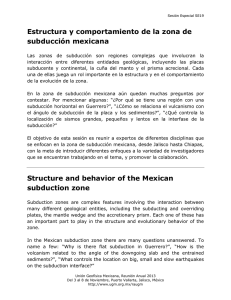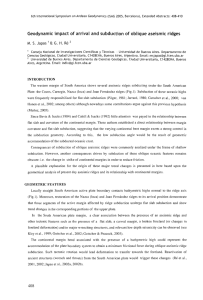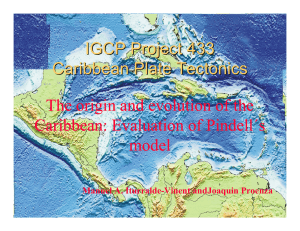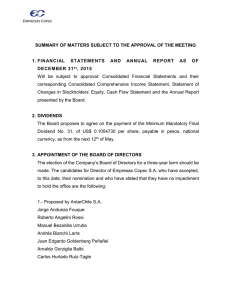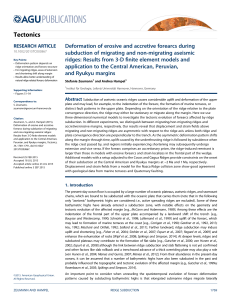the metallogenic evolution of the greater antilles
Anuncio
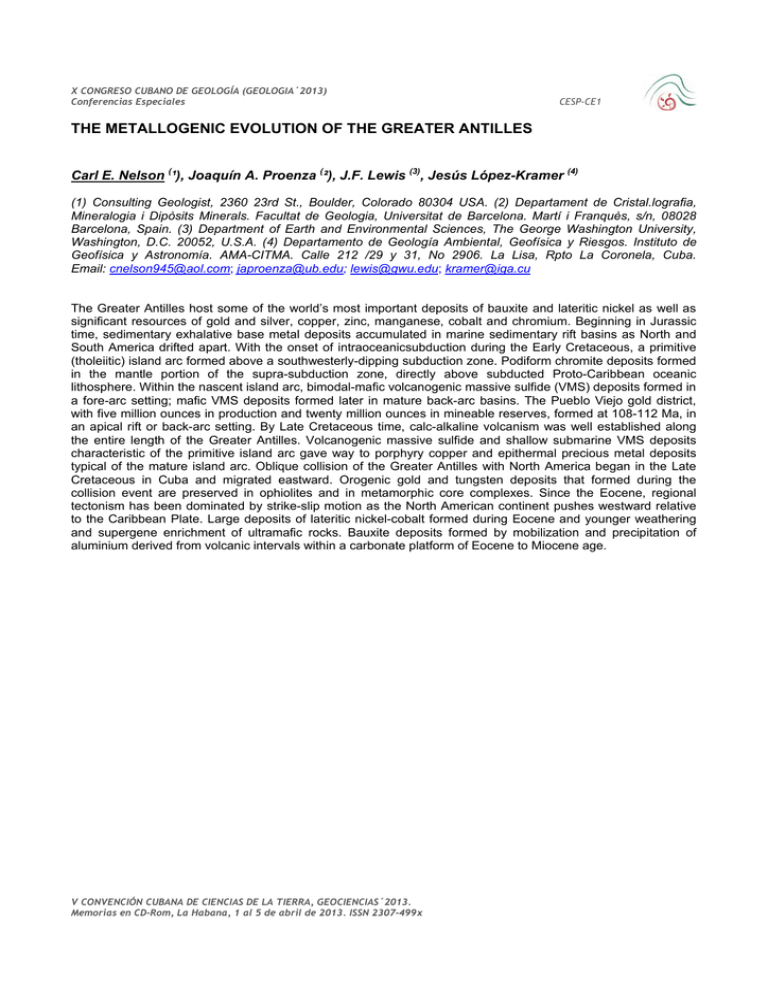
X CONGRESO CUBANO DE GEOLOGÍA (GEOLOGIA´2013) Conferencias Especiales CESP-CE1 THE METALLOGENIC EVOLUTION OF THE GREATER ANTILLES Carl E. Nelson (¹), Joaquín A. Proenza (²), J.F. Lewis (3), Jesús López-Kramer (4) (1) Consulting Geologist, 2360 23rd St., Boulder, Colorado 80304 USA. (2) Departament de Cristal.lografia, Mineralogia i Dipòsits Minerals. Facultat de Geologia, Universitat de Barcelona. Martí i Franquès, s/n, 08028 Barcelona, Spain. (3) Department of Earth and Environmental Sciences, The George Washington University, Washington, D.C. 20052, U.S.A. (4) Departamento de Geología Ambiental, Geofísica y Riesgos. Instituto de Geofísica y Astronomía. AMA-CITMA. Calle 212 /29 y 31, No 2906. La Lisa, Rpto La Coronela, Cuba. Email: cnelson945@aol.com; japroenza@ub.edu; lewis@gwu.edu; kramer@iga.cu The Greater Antilles host some of the world’s most important deposits of bauxite and lateritic nickel as well as significant resources of gold and silver, copper, zinc, manganese, cobalt and chromium. Beginning in Jurassic time, sedimentary exhalative base metal deposits accumulated in marine sedimentary rift basins as North and South America drifted apart. With the onset of intraoceanicsubduction during the Early Cretaceous, a primitive (tholeiitic) island arc formed above a southwesterly-dipping subduction zone. Podiform chromite deposits formed in the mantle portion of the supra-subduction zone, directly above subducted Proto-Caribbean oceanic lithosphere. Within the nascent island arc, bimodal-mafic volcanogenic massive sulfide (VMS) deposits formed in a fore-arc setting; mafic VMS deposits formed later in mature back-arc basins. The Pueblo Viejo gold district, with five million ounces in production and twenty million ounces in mineable reserves, formed at 108-112 Ma, in an apical rift or back-arc setting. By Late Cretaceous time, calc-alkaline volcanism was well established along the entire length of the Greater Antilles. Volcanogenic massive sulfide and shallow submarine VMS deposits characteristic of the primitive island arc gave way to porphyry copper and epithermal precious metal deposits typical of the mature island arc. Oblique collision of the Greater Antilles with North America began in the Late Cretaceous in Cuba and migrated eastward. Orogenic gold and tungsten deposits that formed during the collision event are preserved in ophiolites and in metamorphic core complexes. Since the Eocene, regional tectonism has been dominated by strike-slip motion as the North American continent pushes westward relative to the Caribbean Plate. Large deposits of lateritic nickel-cobalt formed during Eocene and younger weathering and supergene enrichment of ultramafic rocks. Bauxite deposits formed by mobilization and precipitation of aluminium derived from volcanic intervals within a carbonate platform of Eocene to Miocene age. V CONVENCIÓN CUBANA DE CIENCIAS DE LA TIERRA, GEOCIENCIAS´2013. Memorias en CD-Rom, La Habana, 1 al 5 de abril de 2013. ISSN 2307-499x X CONGRESO CUBANO DE GEOLOGÍA (GEOLOGIA´2013) Conferencias Especiales CESP-CE2 140 MILLION YEARS OF SUBDUCTION AND TERRANE COLLISION AND ACCRETION IN THE LEADING EDGE OF THE CARIBBEAN PLATE (WITH EMPHASIS IN CUBA). A METAMORPHIC PERSPECTIVE Antonio García Casco Departamento de Mineralogía y Petrología, Universidad de Granada, España; Associate Researcher, Dept. of Earth and Planetary Sciences, American Museum of Natural History, NY, USA. Email: agcasco@ugr.es The long-lasting evolution of the trailing edge of the Caribbean plate constitutes a fascinating story dominated by ocean (Protocaribbean) - ocean+arc (Caribbean) - continent (North and South America) convergence and collision. This evolution, which is still ongoing, can be traced back (at least) to the early Cretaceous and affects plate-boundary regions that conform a complex orogenic belt that extends from Guatemala through the whole Antillean region, northern South America to the Andean region of Colombia and Ecuador. As shown by the geologic record (e.g., volcanic arc, mafic-ultramafic complexes, metamorphic complexes), and as expected for such an old and long belt of 140 Myr in age and ca. 6000 km in length, respectively, the geodynamic history of the plate margin is complex, involving various types of plate boundary, lithosphere, and kinematic regime. During the early stages of convergence in the early Cretaceous, much of the interactions involved oceanic lithospheres with varied age and thermal state, while arc-continent interaction starting in the latest Cretaceous characterized the Tertiary. In both stages, however, dynamic subduction zones dominated the scenario. The number, geometry and age of these subduction zones are debated. In this talk I shall review the geologic evidence for subduction and collision provided by high- and intermediatepressure metamorphic complexes of the trailing edged of the Caribbean plate (with particular emphasis in Cuba). I shall offer an integrated analysis of subduction, collision and accretion in the region derived from the analysis of thermal evolution rocks formed at depth since the onset of convergence in the plate boundary region. The main goal is not to evaluate geodynamic modes, but to provide first-order constraints for their construction. Many metamorphic complexes document subduction of oceanic lithosphere during the early Cretaceous - early Tertiary. Much of this material is consistent with persistent SE-dipping oceanic subduction of the protoCaribbean below the Caribbean (Pacific) plate, until subduction of platform-derived sedimentary piles (e.g., SW Maya margin, Caribeana, Bahamas, northern South America) took place during the latest Cretaceous-Tertiary. However, metamorphic terranes also indicate that this evolving scenario from steady oceanic subduction to platform subduction and arc-continent collision was not that simple. These complexes, generally "isolated", document a number of intraoceanic interactions (collisions) that make any general geodynamic model for the region to be plagued of uncertainties. Thus, the earliest stages are obscure. Judging from oceanic and arcderived high pressure rocks of Guatemala, west-central Cuba and Hispaniola, the earliest geodynamic scenario entails two subduction zones (i.e., Pacific and proto-Caribbean) of opposite dip or one evolving subduction zone with strong lateral component and a change of sense of dip along-strike. Also, intermediate- and high-pressure metamorphism of volcanic arc sequences, both in the northern (Antillean) and southern (northern South America) branches of the plate margin indicate complexities in the geodynamic scenario during the mid- and late-Cretaceous. The high-pressure arc complexes document subduction of upper-plate volcanic arc material that can be conceptualized in a framework of more than one subduction zone (and, correspondingly, more than one arc). However, there is no need to appeal for complex arc-arc (±continent) interactions (subduction-collisionaccretion) and the problem can be resolved by means of subduction erosion of the Caribbean forearc-arc region with or without a strong strike-slip tectonics. The intermediate-pressure volcanic arc-derived terranes, however, document episodic events of mid-late Cretaceous intraoceanic collisions of two different arcs (or fragments of one arc) in the Antillean region and the Tertiary collision between the Caribbean arc and northern South America (when, as a result, subduction of the Caribbean plate below northern South America started). Scarce metamorphic soles in the Antillean sector, with development of intermediate-P meta-MORB complexes below the ophiolitic slices, reveal late Cretaceous onset of obduction of oceanic lithosphere. At this stage, arc-continent collision is not recorded, and the simplest explanation for onset of obduction implies the development of nascent subduction zones in the Caribbean back-arc region. In conclusion, metamorphic complexes do not support a simple picture of steady oceanic subduction during the Cretaceous followed by latest Cretaceous Tertiary subduction/collision of the continental margins of N and S America. Instead, unveils a dynamic scenario with changing (in time and space) plate boundary geometries, similar to that of present-day western Pacific arcs. V CONVENCIÓN CUBANA DE CIENCIAS DE LA TIERRA, GEOCIENCIAS´2013. Memorias en CD-Rom, La Habana, 1 al 5 de abril de 2013. ISSN 2307-499X X CONGRESO CUBANO DE GEOLOGÍA (GEOLOGIA´2013) Conferencias Especiales V CONVENCIÓN CUBANA DE CIENCIAS DE LA TIERRA, GEOCIENCIAS´2013. Memorias en CD-Rom, La Habana, 1 al 5 de abril de 2013. ISSN 2307-499X CESP-CE2 X CONGRESO CUBANO DE GEOLOGÍA (GEOLOGIA´2013) Conferencias Especiales CESP-CE3 MAGMATIC AND SEISMIC EVIDENCE FOR CONTINENTAL LITHOSPHERIC EVOLUTION OF THE ANDEAN MARGIN UNDER THE SOUTHERN CENTRAL VOLCANIC ZONE ARC AND PUNA PLATEAU (25°-28°S LATITUDE) Suzanne Mahlburg Kay(1), Beatriz Coira SeismicTeam(1, 3, 4) (2) , Ben Heit(3), Eric Sandvol(4), Puna 1. Dept of Earth and Atmospheric Sciences, Cornell University, Ithaca, NY, USA;2. CONICET, Casilla de Correo 258, (4600) San Salvador de Jujuy, Argentina; 3. GeoForschZentrum, Telegrafenberg, D-14473 Potsdam, Germany; 4.Dept. Geol. Sci., University of Missouri, Columbia, MO 65211, USA. The Central Andean margin has been proposed as a site of crustal destruction by forearc subduction erosion and delamination (or foundering) of thick dense continental crust as well as an area of crustal addition and reworking by arc magmatic processes. These destruction processes are supported both by the magmatic record and by newly processed mantle and crustal earthquake distributions and tomographic and receiver function images from the 2007-2009 southern PUNA passive seismic experiment (see Bianchi et al, 2013, Tectonophysics). A strong argument for late Neogene forearc subduction erosion in the southern Central Volcanic Zone region comes from an ~45 km eastward displacement of the volcanic arc front from ~27°S to 28°S at 8 to 3 Ma. The glassy andesitic magmas with extreme adakitic signatures (high Sm/Yb and Sr/Yb ratios) that erupted over the hinge of the shallowing Nazca plate as the Chilean-Pampean flatslab shallowed to the south during this time are interpreted to contain melt components from the removed forearc lithosphere (Goss, Kay, Mpodozis, 2013, Journal Petrology). A high attenuation seismic anomaly above the slab, which is present under part of this region, might be interpreted as being related to a remnant of a subduction channel that carried removed forearc lithosphere eastward. A geochemical signal of the removed lithosphere is reflected in the isotopic signatures of the most primitive basalts erupted in the region. In the backarc, the chemistry and distribution of the giant 6 to 2 Ma Cerro Galan ignimbrites and the < 7 Ma mafic calc-alkaline and intraplate-like lavas in the southern Puna have been attributed to mantle decompression melting in the aftermath of delamination of thickened mafic crust as a formerly shallowly dipping subducting Nazca plate steepened after 7 Ma. A west to east seismic tomographic image through the Cerro Galan caldera region supports this interpretation in showing an ~100 km long high velocity anomaly above the subducting plate that is interpreted as the most recently delaminated crust and lithosphere. The low Vs, Vp and high Qp crustal and mantle seismic anomalies under the areas of young Puna mafic to silicic volcanic rocks are interpreted as reflecting zones of on-going partial melting in the mantle and crust. Both seismic receiver function images and calculated mantle equilibration depths of young basaltic magmas attest to a less than 80 km thick lithosphere under the irregular base of the ~45-75 km thick southern Puna crust. Evidence for ongoing partial melting in the mantle and crust along with a seismic swarm at < 15 km beneath the > 2 million year old resurgent dome in the Cerro Galan caldera are consistent with partial melting under the southern Puna plateau continuing the giant late Neogene ignimbrite flare-up under the Central Andean Puna plateau. V CONVENCIÓN CUBANA DE CIENCIAS DE LA TIERRA, GEOCIENCIAS´2013. Memorias en CD-Rom, La Habana, 1 al 5 de abril de 2013. ISSN 2307-499X IV CONGRESO CUBANO DE PETROLEO Y GAS (PETROGAS´2013) CESP-C4 CONFERENCIA ESPECIAL GAS NO–CONVENCIONAL: ¿REVOLUCION ENERGERTICA? Dr. Manuel Marrero Faz Ministerio de Energía y Minas de Cuba Se muestra la definición y los tipos de gas no-convencional (GNC) y sus características principales .Se presentan los métodos de exploración y producción utilizados para el GNC. Se informa sobre la producción mundial de gas natural no-convencional y su distribución por países. Se presentan las áreas más perspectivas para la exploración de GNC en Cuba y sus posibilidades de ejecución. Se exponen los aspectos relacionados con el medio ambiente y el GNC .Por último, se ofrecen criterios sobre el futuro inmediato y mediato del GNC .Se ofrecerá a todos los presentes un GLOSARIO de términos sobre el GNC (en inglés y español). V CONVENCIÓN CUBANA DE CIENCIAS DE LA TIERRA, GEOCIENCIAS´2013. Memorias en CD-Rom, La Habana, 1 al 5 de abril de 2013. ISSN 2307-499X X CONGRESO CUBANO DE GEOLOGÍA (GEOLOGIA´2013) Conferencias Especiales CESP-CE5 LÉXICO ESTRATIGRÁFICO DE MÉXICO Y SU UTILIDAD EN LA CARTOGRAFÍA GEOLÓGICA NACIONAL Isabel López Palomino(1) 1. Servicio Geológico Mexicano, Boulevard Felipe Ángeles, km. 93.50-4, Col. Venta Prieta, 42080, Pachuca, Hidalgo, México, ilpalomino@sgm.gob.mx Una de las problemáticas más recurrentes en el desarrollo de los trabajos geológicos, es la dificultad en el reconocimiento de las unidades y sus relaciones estratigráficas fuera de sus áreas tipo. Este problema, es causado principalmente por el empleo inapropiado e indiscriminado de nombres para las unidades estratigráficas, lo cual se refleja en la duplicidad de éstos; es decir, se emplea el mismo nombre para unidades con características líticas diferentes (homonimia) o bien, el uso de diversos nombres para la misma unidad (sinonimia). Otra problemática persistente es la relacionada con la posición estratigráfica asignada a las unidades por diferentes autores, la cual, generalmente difieren entre sí, lo que dificulta la interpretación de la evolución geológica de una región. De manera particular, esta problemática de la nomenclatura se refleja en los trabajos cartográficos, en los cuales es extendida la dificultad para identificar y discriminar las unidades estratigráficas fuera de su localidad tipo; lo que conlleva a renombrar formaciones con términos operativos, que han ampliado el número de nombres de unidades geológicas y han generado dificultad en el uso apropiado de la nomenclatura estratigráfica. Por lo anterior, el Servicio Geológico Mexicano (SGM) tomó la iniciativa de elaborar el primer Léxico Estratigráfico de México, proyecto que tiene como objetivo analizar y sistematizar la información disponible acerca del registro geológico de las unidades estratigráficas en el territorio nacional, y conocer el estado actual de su nomenclatura. Este análisis se desarrolla con apego a los procedimientos establecidos en el Código Estratigráfico Norteamericano, en sus diferentes versiones, y con la colaboración bajo convenio de algunas instituciones académicas del país. Así pues, la homogenización nomenclatural del LEM, debe entenderse como un proceso continuo, en el cual la comunidad geológica mexicana utilizará una misma nomenclatura estratigráfica en la medida que la información de las unidades geológicas sea rigurosa, actualizada y de amplia divulgación. V CONVENCIÓN CUBANA DE CIENCIAS DE LA TIERRA, GEOCIENCIAS´2013. Memorias en CD-Rom, La Habana, 1 al 5 de abril de 2013. ISSN 2307-499X
